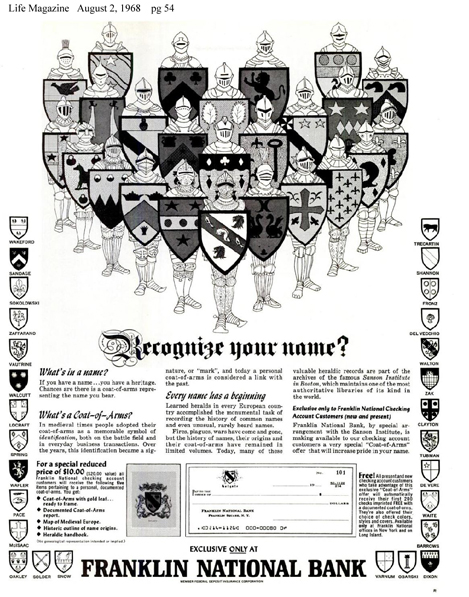Sanson Institute of Heraldry
Boston, Massachusetts1960-1975
The Business and Marketing Saga of the Sanson Institiute
As a Massachusetts business, the Sanson Institute operated essentially from 1960 when it started its direct marketing activities until 1975 when its assets were sold and its business closed. In a ghostly afterlife, the corporate shell was used by another business entity to try and sell manufactured housing which failed, and then the dormant corporation was moved to Las Vegas about 2000 where under new name and with new entrepreneurs, it markets to the public new products (unrelated to its original Boston heraldic items business) using direct marketing strategies. Efforts to recycle some of its earlier newspaper promotional material "What's in a Name" resurfaced elsewhere.
The Company's operations during its 15 year history was led by four Boston based entrepreneurs who had come together by common association with a Boston discount department store with a legendary style of promotion in the Boston area. That store was Raymond's Department Store which after about 70 years of business existence fell victim to the recessionary economy of 1980 and went out of business.
The Beginnings
The start of the Sanson Institute of Heraldry has its major foundation in a March 1960 event held at Raymond's Department Store in Boston. An artist by the name of Albert Edwin Seddon, born in Ireland and just about four years in Boston and the USA, finds the opportunity for an exhibition of his artistic work at Raymond's. In a city dense with a poplation of recent Irish ancestry, and with artistic depiction of Irish republican icons, it was a good appeal.
In the advertising deparment of Raymond's was a Boston born and educated man named Charles E. Guarino. Albert Seddon and Charles Guarino both had training in art and curiosity about historical things. With the art exhibition and promotion, Guarino and Seddon became familiar with each other. They linked up to market the Sanson Institute.
The start of the Sanson Institute of Heraldry has its major foundation in a March 1960 event held at Raymond's Department Store in Boston. An artist by the name of Albert Edwin Seddon, born in Ireland and just about four years in Boston and the USA, finds the opportunity for an exhibition of his artistic work at Raymond's. In a city dense with a poplation of recent Irish ancestry, and with artistic depiction of Irish republican icons, it was a good appeal.
In the advertising deparment of Raymond's was a Boston born and educated man named Charles E. Guarino. Albert Seddon and Charles Guarino both had training in art and curiosity about historical things. With the art exhibition and promotion, Guarino and Seddon became familiar with each other. They linked up to market the Sanson Institute.
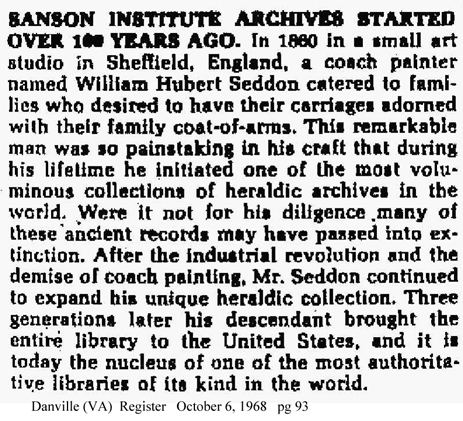
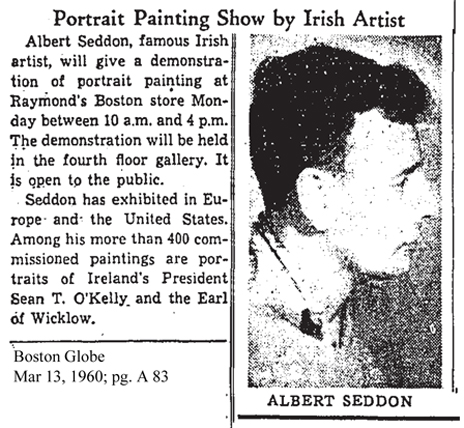
By September 1960 the first direct marketing activity for the Sanson Institute was begun. But it was not for selling status enhancing heraldic certificates, reports and bric-a-brac. That would not start until 1963. The first three years of the Sanson Institute were devoted to marketing other products: a Judo-Karate course with scientific and secrets techniques; building outlines for everything and etc. etc.for only 35 cents, and 6 art lessons for less than the cost of a paint brush. We note in one ad claim that the Sanson Institute was established in 1937 -- something of an inconsistency with other claims made elsewhere.
In 1963 the first ad appeared by the Sanson Institute for the heraldic market. This initiated a period of growth and came at the same time as the set up and growth of other businesses around the country selling heraldic artifacts of dubious authenticity to the American market. But it was paydirt for the Sanson Institute.
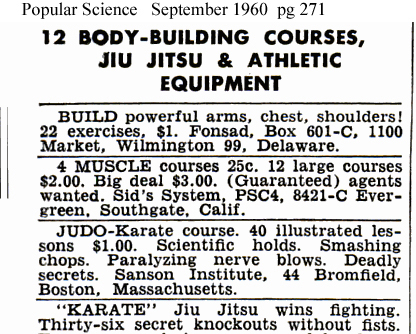
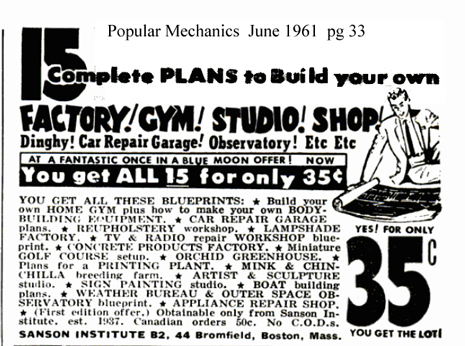
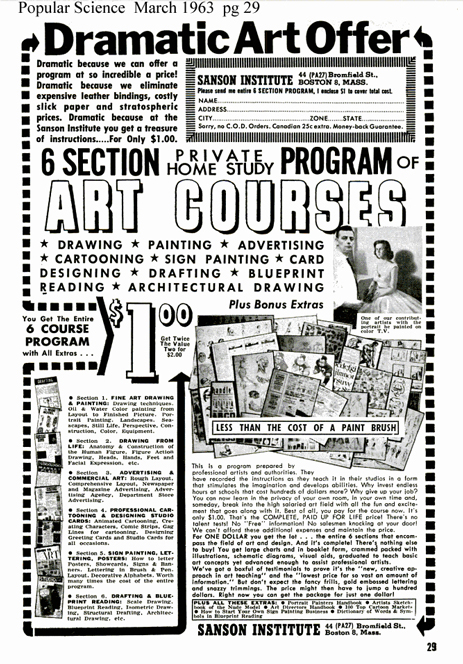
With enough business, the company moved into new offices at 5 Bromfield Street where it stayed until 1966. The ad agency opened up a 'Heraldic Hall' in 1964 on Washington Street to promote the heraldry business to the local Boston market and to provide working room for the business.
With a need for expanded business options and the capital to underwrite, new people would need to be involved. Charles Guarino was to continue his job with Raymond's advertising department.
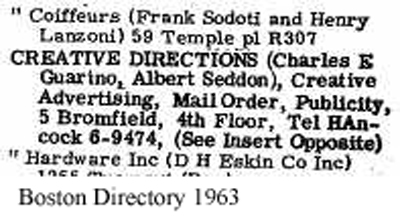
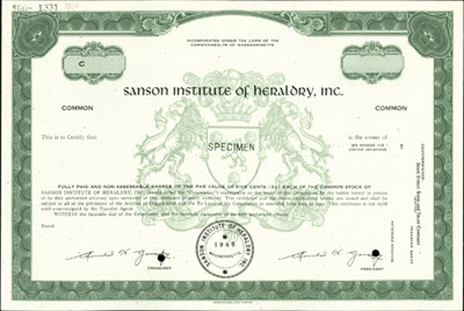
In late 1965 a decision was made to expand big time. At about this time, Charles Guarino quit his job at Raymond's Dept. Store advertising department. In early 1966, the company was incorporated with two new partners from the Boston area and additional resources. The first individual was Arnold H. Gorsky who became President and Treasurer. His signature is on the stock certificate at the right..
The second individual was Norman Kenneth Kandler. Both Gorsky and Kandler were significantly involved with Raymond's Department Store at one time or another. Gorsky was involved in the 1960's era of Raymond's expansion into stores specializing in tire and auto accessories in the Boston market. Kandler had worked for a company merchandising housewares, hardware and other items as a concession in the Raymond's Department Store.
The year 1966 would be the beginning of the big time for Sanson Institute of Heraldry, Inc..
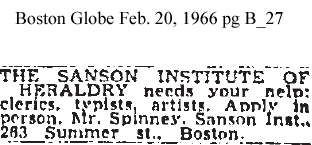
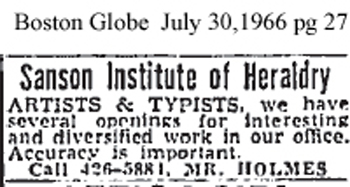
The year started with a full page ad in the January 16, 1966 issue of the New York Times with 480,000 coats of arms claimed to be in its files. In March 1966, the company scored a public relations home run by getting on NBC's "The Tonight Show". They had prepared family surname heraldry plaques and stories for Johnny Carson, Ed McMahon and then orchestra director Skitch Henderson.
By the time 1967 rolled around business was good. Guarino and Seddon incorporated their Creative Directions ad agency. Guarino, Seddon and Kandler formed another corporation GSK Enterprises at the same time to provide other business services. A nationally syndicated newspaper column "What's in a Name" was sold to dozens of newspapers thoughout the U.S.. In Boston, a weekly radio program was broadcast and syndicated to other smaller markets.
In a Feb. 4, 1968 Boston Globe article "Boston Firm Profits by 'What's in a Name?'", Sanson Institute President Arnold Gorsky boasted "We are the biggest suppliers of titles in the world." He went on to report that thed had 170,000 customers in 1967. While claiming that they were honest with no name in the records no coat of arms, he did admit that there work is not true genealogy; that they "research the oldest coat of arms bearing your name but it does not necessarily represent your actual lineage." The reported staff of the company at the time was reported as 40 people. At the time Gorsky reported he was trying to sell the heraldry dashboard decorations to automotive manufactures for cars to their customers and dealing with a bank. That bank turned out to be the Franklin National Bank of historic fame for its collapse as a fraud.
